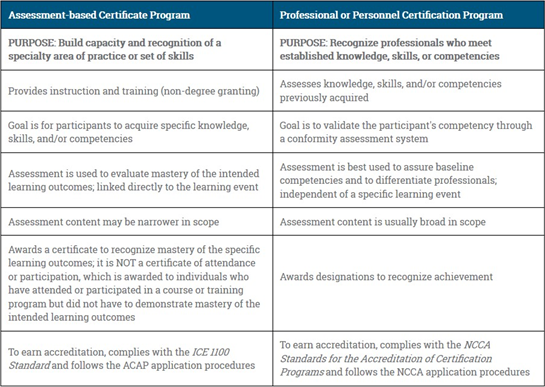
If you are contemplating learning how to perform ergonomics evaluations you might be asking yourself, “What is the difference between a Certificate vs. Certification in Ergonomics and are they necessary?”
Having in-house expertise in ergonomics or working with an outside ergonomics consultant is a critical link in managing ergonomic risk and saving money. But is the in-house trained employee or the ergonomics consultant qualified to do what is needed? To assure you get the results you need and expect, understanding the differences in the ergonomics designations in the marketplace will bring clarity to your decision.
Certificate vs. Certification: Understand the Differences
There are both professional certification programs and assessment-based certificate programs. So, what are the differences?
While either option is beneficial, certification is considered far more valuable as it recognizes achievement. More directly, in the following ways:
- Applicant must qualify by education (BS, MS or higher education), then “test in” to be certified in the first place;
- Applicant must maintain certification through continuing education for whatever duration, however many units; and
- There is generally a certifying Board that reviews all applications and makes an educated decision as to whether to certify based on foundational education, then test scores and additional required documentation such as work samples or testimonials from other professionals.
Certification verifies the applicant meets the qualifications to earn the professional designation. Bottom line, certification holds, measures, and judges to a higher standard of achievement.
Whereas, a certificate program typically indicates attendance, participation or completion of a course or a series of courses with a specific focus without the associated pre-requisites of knowledge, skills, and experience. Typically, these courses are open to newcomers and those with experience. Any group can offer a certificate program. See Figure 2. for common ergonomic designations in the marketplace.
The Institute for Credentialing Excellence (ICE) differentiates assessment-based certificate programs from professional or personnel certification programs. This is very helpful in understanding the “alphabet soup” of ergonomic certificates and certifications existing in the ergonomic marketplace today.
However, it isn’t always so clear cut as some course providers offer testing and submission of sample work for review, yet they are not “certifying boards,” they are for-profit businesses.
The information on this page is produced and copyright protected by the Institute for Credentialing Excellence. Use with permission only.

Figure 1. This table sorts out certificate vs. certification program. Used with permission by ©Institute for Credentialing Excellence.
What Designations Exist in the Ergonomics Marketplace?
There are many courses offering ergonomic designations in the marketplace provided by various non-profit and corporate organizations. They have similarities and differences, so be sure to read closely regarding what is included and required to earn the specific designation.
Here are some of the most common ergonomic certificates and certifications offered in the marketplace today (excludes university degrees) and the type of program design based on the ICE descriptions.
| Assessment-based Certificate | |
|---|---|
| Designation Offered | Organization |
| Certified Office Ergonomics Specialist or COESp | Worksite International, Inc. |
| Certified Chair Assessment Specialist or CASp | Worksite International, Inc. |
| Certified Ergonomic Evaluator Specialist or CEES | Matheson |
| Certified Ergonomic Assessment Specialist or CEAS I, II, III | The Back School |
| Certified Office Ergonomic Evaluator or COEE | Occupro |
| Certified Office Ergonomic Evaluator or COEE | Humanscale |
| Certified Associate Ergonomist or CAE | Oxford Research Institute (ORI) |
| Certified Assistant Ergonomist or CAsE | Oxford Research Institute (ORI) |
| Professional Certification Program; Board Certification | |
| Designation Offered | Organization |
| Certified Professional Ergonomist or CPE |
*Board of Certified Professional Ergonomists (BCPE) *International Ergonomics Association Endorsement based on ISO/IEC 17024 standard for certifying bodies. |
| Associate Ergonomics Professional or AEP | Board of Certified Professional Ergonomists (BCPE) |
| Certified Industrial Ergonomist or CIE | Oxford Research Institute (ORI) |
Figure 2. Common ergonomics designations in the marketplace based on ICE criteria. Does not include university degrees.
Office Ergonomics is Not So Easy!
Office Ergonomics is far more complicated than it used to be. Multiple monitor use; multiple devices on the desktop; laptop and PC use, tablets and cell phones; specialized software; alternative ergonomically designed keyboards and mice; advanced seating design and the sit to stand workstation. And that is just the “machine” side of it. Not to mention the complexity humans bring to the equation, especially those with symptoms or medical conditions.
Suddenly, office ergonomics isn’t so easy anymore. To add to the complexity, now people are working remotely at home. Understanding the relationship between the human: machine interface in the office and home is more complex than ever making ergonomics certificates and certifications even more important.
Is a Certificate or Certification Needed to Perform Ergonomic Evaluations?
By law, no. There is no license or state or federal requirement requiring a certificate or certification to perform an ergonomic evaluation. But for quality assurance and successful outcomes, yes, and here is why.
Do you remember playing “Whisper Down the Lane” as a child? It’s a game in which a message is passed on, in a whisper, by each of several people, so that the final version often radically changes from the original. Well, in my experience, I have met many individuals who learned ergonomics this way. They never attended any classes, but learned from others through on the job training; picking up tidbits of information along the way with no real contextual learning on the methods, theories, and practices a trained ergonomics practitioner would use.
Employees on the receiving end of these well-intended individuals receive the short end of the stick by not getting the full value of what ergonomics really is. And it serves to propagate many half-truths, myths, and flat out lies about ergonomics, workstation set up and safe work practices. For this reason, making sure employers have at least one person in-house who has participated in a credentialed ergonomics training program is vital for success. Or use an ergonomics consultant who already has the professional credentials to show.
Employers need qualified ergonomic specialists in the workplace to step up and take care of new hires; assist their peers who need help with their workstation and chair set up and to assist with equipment selection and fit. And now, to perform remote home office evaluations.
By utilizing in-house expertise in ergonomic analysis, an employer can save approximately $300.00-500.00 in direct costs for every preventive ergonomic evaluation performed on healthy workers, before they develop problems, which effectively minimizes the likelihood of employee claim filing for seated work injuries in the future. At an average cost of $40,000.00 per claim, according to the California Department of Industrial Relations (2017), there is nothing more valuable than having a qualified ergonomics professional help to prevent injuries.
There is a Difference!
Based on this blog, my research, and feedback from several certified professional ergonomists (CPE), there is a difference in certificate vs. certification, and it should be respected. There are definite differences in the level of expertise and experience those with ergonomics certificates bring to bear vs. those with professional certification designation. Being clear on your project goals and the professional who will best help you achieve it is important.
Ergonomics certification is necessary and worthwhile for validity, professionalism, and safety in the workplace while helping to preserve the integrity of our profession. Certificates and certifications in ergonomics protect employers and employees by providing legal justification. They also demonstrate the practitioner has the qualifications to perform the evaluations to make the recommendations necessary to protect employees. It also serves to differentiate the practitioner in the ergonomics marketplace. And since there is no state or federal licensing requirements in ergonomics, this is the best we can do for now.
If you have an opinion or question about “certificate vs. certification” write your comments below. I’m still trying to sort it all out and welcome your thoughts!


Comments (4)